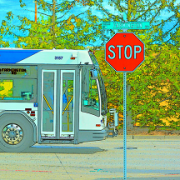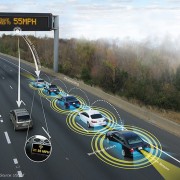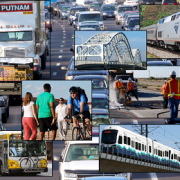Posts
Silicon Valley Buses Adopt DSRC and V2I to Speed Rides, Cut Fuel Use
/0 Comments/in Article, Consumer, Government, Impact, Technology, Technology Company, TransportationBurney Simpson
Riding the bus isn’t usually high-tech but a new app in Silicon Valley designed to make public bus operations more efficient is using Dedicated Short Range Communication (DSRC) to conduct Vehicle-to-Infrastructure (V2I) communication.
Arada Systems teamed with eTrans Systems to develop the computer-enabled Smart Stop that gives waiting commuters the capability to send a request to the bus driver that they want to be picked up. Smart Stop was developed with the Santa Clara Valley Transportation Agency, the county agency that operates the buses.
The VTA is implementing Smart Stop to make its bus routes more efficient and to lower fuel use.
“Connected vehicle technologies can contribute significantly to creating a simplified ridership experience, allowing buses to communicate with passengers at bus stops to ensure no passenger is missed yet only stopping when there is a passenger for the specific route to save fuel,” said Gary Miskell, chief information officer with the VTA.
Bus stops will be equipped with a hardened mobile computer with a 10-inch touch screen that can conduct V2I communication with a moving bus by using the DSRC wave length.
Fairfax, Va.-based eTrans specializes in the development and security of connected vehicle systems. Clients include automotive, transit, insurance and academic institutions.
eTrans Systems is pleased to lead the smart-stop project with the VTA and Arada Systems,” said John Estrada, CEO of eTrans. “Smart-Stop will both improve and increase ridership in Silicon Valley.”
“Arada Systems is pleased to partner with VTA to promote smart ridership”, said Praveen Singh, CEO of Arada Systems, Inc., “Our goal is to show the while DSRC is imperative for vehicle safety, it can also be used for other smart applications like Smart-Stop.” “
Vehicle to Infrastructure technology allows vehicles to interact with each other when travelling at high-speeds, providing drivers warnings about potential hazards, and possibly avoiding accidents. The National Highway Traffic Safety Administration (NHTSA) projects that this kind of advanced communication can reduce up to 80 percent of the vehicle crashes in the U.S.
Troy, Mich.-based Arada Systems develops, licenses and provides end to end solutions for the next generation connected and semi-autonomous vehicle technologies.
Photo: Tri Met Bus by Swong95765, 2014.
DOT Lists its Connected Vehicle Safety Apps in Fact Sheet
/0 Comments/in Article, Government, Impact, TechnologyThe U.S. Department of Transportation has released a handy fact sheet on connected vehicles that lists and briefly describes the major safety applications that connected technology is addressing. The two-page Connected Vehicle Applications: Safety is a pdf-format guide that categorizes the 29 projects by Vehicle-to-Infrastructure (V2I), Vehicle-to-Vehicle (V2V), and Vehicle-to-Pedestrian (V2P).
Under V2I, the fact sheet lists and describes such applications as Oversize Vehicle Warning, Reduced Speed/Work Zone Warning, Spot Weather Impact Warning, Warnings About Hazards in Work Zone and others.
For example, the description under Red Light Violation Warning is: “Broadcasts signal phase and timing (SPaT) and other data to the in-vehicle device, allowing warnings to drivers of impending red light violations.”
Under V2V applications, the applications include Blind Spot/Lane Change Warning, Forward Collision Warning, Tailgating Advisory, and Situational Awareness.
The single application listed under V2P is Transit Pedestrian Application.
The fact sheet also links to the Connected Vehicle Reference Implementation Architecture website for those seeking more details.
Michigan Senator proposes funds for vehicle-to-infrastructure technology
/0 Comments/in Future, Industry, Legal, News, Technology, TransportationDetroit Free Press
Driverless Trans Part of DOT Budget Battle
/0 Comments/in Article, Future, Government, Industry, TransportationBurney Simpson
Driverless transportation came to the fore last week as Congress considered President Obama’s 2016 budget request for the U.S. Department of Transportation. Proponents took the fight to voters, traveling out of Washington to convince the public to support the $95 billion proposal.
As part of that Obama asked Congress for $935 million over six years for the line item on autonomous driving technology called ‘Intelligent Transportation Systems & Automation Research Acceleration,’ (see pages 6 and 10 in this DOT Budget Highlights pdf).
DOT Secretary Anthony Foxx went to Silicon Valley last week, appearing at Delphi Labs in Mountain View, Calif., and arguing for his Beyond Traffic 2045 concept first launched in February.
Foxx pushed for greater road-related communication infrastructure, including requiring vehicle to vehicle (V2V) communication in all new cars. Foxx said he plans to send the rule request to federal regulators before the end of this year, speeding up the rule-making process from his previous plan.
The DOT’s National Highway Traffic Safety Administration is working with the Federal Communication Commission to test dedicated short-range communications (DSRC) standards in the 5.9GHz spectrum. The wireless protocols are used for V2V and vehicle to infrastructure (V2I) communications.
It’s not clear if driverless technology is a headline grabber that encourages voters to contact their elected officials to get behind the proposed budget. In the 1980s President Ronald Reagan drew widespread public backing for funding of his ‘Star Wars’ weapons shield in space that he said would protect America from nuclear rockets sent from the Soviet Union.
STATE INFRASTRUCTURE
Meanwhile, in Pennsylvania, construction unions joined with former Gov. Ed Rendell to publicize funding requests for transportation and infrastructure. The unions would like to raise the state gas tax to pay for the repair and construction of roads and bridges. Proponents say the gas tax was last increased in 1994.
Other states are raising their gas tax. Iowa implemented an increase in March, its first since 1984, and last week the Nebraska legislature overrode the governor’s veto to enact an increase that will start next year.
A recent article in the Harvard Business Review contends that giant transportation projects will only be completed if leaders build collaboration among a mix of supporters. In ‘Too Many Infrastructure Projects go it Alone’ author Rosabeth Moss Kanter writes,
“Systemic problems that affect everyone but are beyond the ability of any one person to solve require collaboration skills. To renew and reinvent our aging transportation infrastructure, we must turn our attention to coalition-building. Classic leadership lessons apply.
To create the conditions that support innovation, leaders need to build connections across companies, industries, and sectors.”
Kanter points to a number of successful collaborative projects including the 32-acre M City autonomous-vehicle test bed set to officially open this July in Ann Arbor, Mich. That project grew in part due to the coming together of major automakers, Google, the University of Michigan, the state DOT, and other interested parties, Kanter writes.



